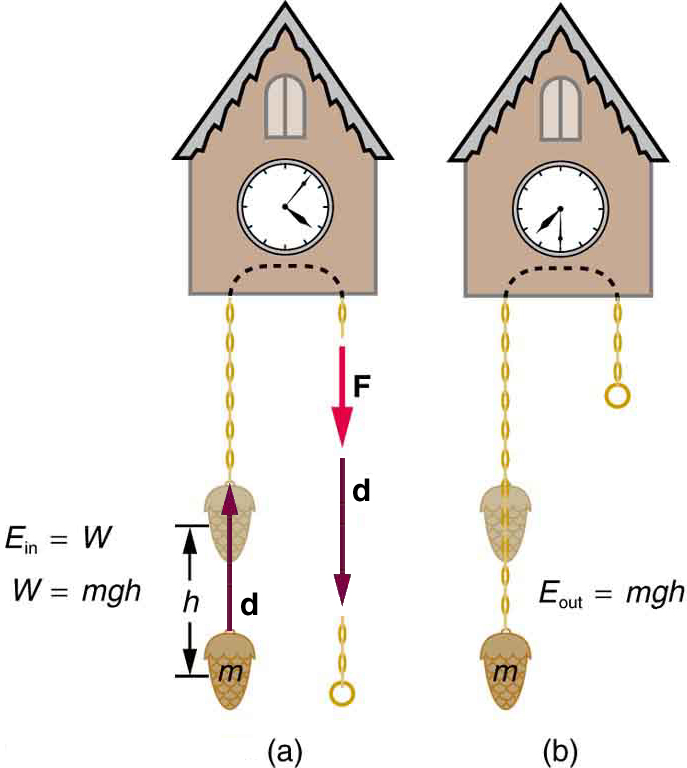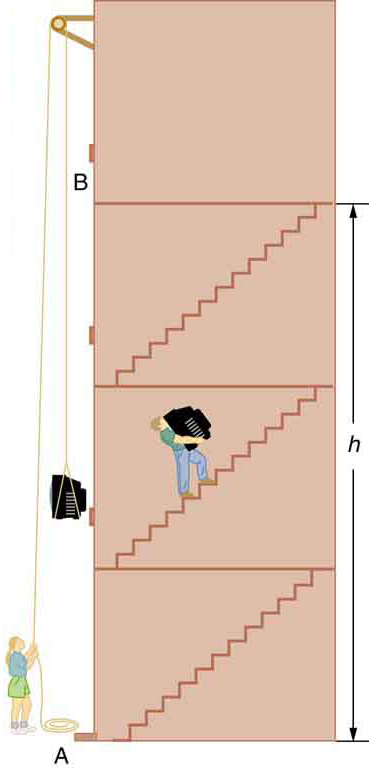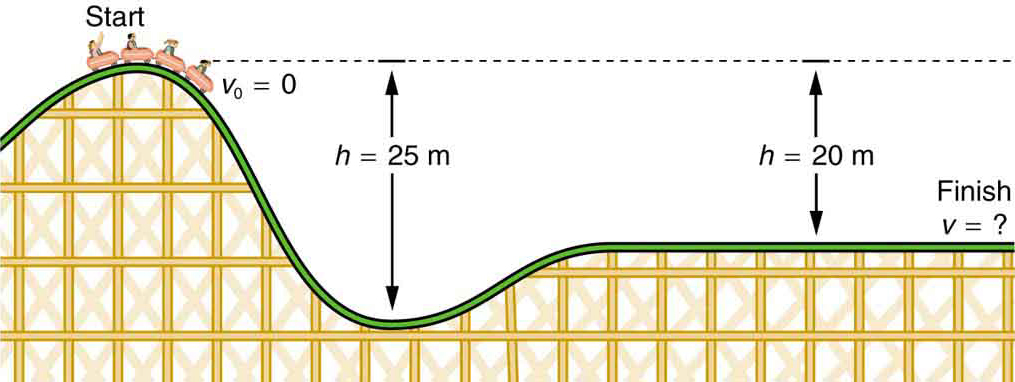Chapter 5: Work, Power, and Energy
5.3 Gravitational Potential Energy
Authors: Paul Peter Urone, Roger Hinrichs
Adapted by: Rob Pryce, Alix Blacklin
Learning Objectives
By the end of this section, you will be able to:
- Explain gravitational potential energy in terms of work done against gravity.
- Show that the gravitational potential energy of an object of mass [latex]m[/latex] at height [latex]h[/latex] on Earth is given by [latex]{\text{PE}}_{\text{g}}=\text{mgh}[/latex].
- Show how knowledge of the potential energy as a function of position can be used to simplify calculations and explain physical phenomena.
Work Done Against Gravity
Climbing stairs and lifting objects is work in both the scientific and everyday sense—it is work done against the gravitational force. When there is work, there is a transformation of energy. The work done against the gravitational force goes into an important form of stored energy that we will explore in this section.
Let us calculate the work done in lifting an object of mass [latex]m[/latex] through a height [latex]h[/latex], such as in Figure 7.6. If the object is lifted straight up at constant speed, then the force needed to lift it is equal to its weight [latex]\text{mg}[/latex] and the displacement is equal to the height it was lifted. Therefore, the work done on the mass is then [latex]\text{W = Fd = mgh}[/latex]. We define this to be the gravitational potential energy [latex]\left({\text{PE}}_{\text{g}}\right)[/latex] put into (or gained by) the object-Earth system.
This energy is associated with the state of separation between two objects that attract each other by the gravitational force. For convenience, we refer to this as the [latex]{\text{PE}}_{\text{g}}[/latex] gained by the object, recognizing that this is energy stored in the gravitational field of Earth.
Why do we use the word “system”? Potential energy is a property of a system rather than of a single object—due to its physical position. An object’s gravitational potential is due to its position relative to the surroundings within the Earth-object system. The force applied to the object is an external force, from outside the system. When it does positive work it increases the gravitational potential energy of the system. Because gravitational potential energy depends on relative position, we need a reference level at which to set the potential energy equal to 0. We usually choose this point to be Earth’s surface, but this point is arbitrary; what is important is the difference in gravitational potential energy, because this difference is what relates to the work done. The difference in gravitational potential energy of an object (in the Earth-object system) between two rungs of a ladder will be the same for the first two rungs as for the last two rungs.
Converting Between Potential Energy and Kinetic Energy
Gravitational potential energy may be converted to other forms of energy, such as kinetic energy. If we release the mass, gravitational force will do an amount of work equal to [latex]\text{mgh}[/latex] on it, thereby increasing its kinetic energy by that same amount (by the work-energy theorem). We will find it more useful to consider just the conversion of [latex]{\text{PE}}_{\text{g}}[/latex] to [latex]\text{KE}[/latex] without explicitly considering the intermediate step of work. (See Examples below). This shortcut makes it is easier to solve problems using energy (if possible) rather than explicitly using forces.

More precisely, we define the change in gravitational potential energy [latex]\text{Δ}{\text{PE}}_{\text{g}}[/latex] to be
where, for simplicity, we denote the change in height by [latex]h[/latex] rather than the usual [latex]\text{Δ}h[/latex]. Note that [latex]h[/latex] is positive when the final height is greater than the initial height, and vice versa. For example, if a 0.500-kg mass hung from a cuckoo clock is raised 1.00 m, then its change in gravitational potential energy is
Note that the units of gravitational potential energy turn out to be joules, the same as for work and other forms of energy. As the clock runs, the mass is lowered. We can think of the mass as gradually giving up its 4.90 J of gravitational potential energy, without directly considering the force of gravity that does the work.
Using Potential Energy to Simplify Calculations
The equation [latex]\text{Δ}{\text{PE}}_{\text{g}}=\text{mgh}[/latex] applies for any path that has a change in height of [latex]h[/latex], not just when the mass is lifted straight up. (See Figure 7.8.) It is much easier to calculate [latex]\text{mgh}[/latex] (a simple multiplication) than it is to calculate the work done along a complicated path. The idea of gravitational potential energy has the double advantage that it is very broadly applicable and it makes calculations easier. From now on, we will consider that any change in vertical position [latex]h[/latex] of a mass [latex]m[/latex] is accompanied by a change in gravitational potential energy [latex]\text{mgh}[/latex], and we will avoid the equivalent but more difficult task of calculating work done by or against the gravitational force.

The Force to Stop Falling
A 60.0-kg person jumps onto the floor from a height of 3.00 m. If he lands stiffly (with his knee joints compressing by 0.500 cm), calculate the force on the knee joints.
Strategy
This person’s energy is brought to zero in this situation by the work done on him by the floor as he stops. The initial [latex]{\text{PE}}_{\text{g}}[/latex] is transformed into [latex]\text{KE}[/latex] as he falls. The work done by the floor reduces this kinetic energy to zero.
Solution
The work done on the person by the floor as he stops is given by
with a minus sign because the displacement while stopping and the force from floor are in opposite directions [latex]\left(\text{cos}\phantom{\rule{0.25em}{0ex}}\theta =\text{cos}\phantom{\rule{0.25em}{0ex}}\text{180º}=-1\right)[/latex]. The floor removes energy from the system, so it does negative work.
The kinetic energy the person has upon reaching the floor is the amount of potential energy lost by falling through height [latex]h[/latex]:
The distance [latex]d[/latex] that the person’s knees bend is much smaller than the height [latex]h[/latex] of the fall, so the additional change in gravitational potential energy during the knee bend is ignored.
The work [latex]W[/latex] done by the floor on the person stops the person and brings the person’s kinetic energy to zero:
Combining this equation with the expression for [latex]W[/latex] gives
Recalling that [latex]h[/latex] is negative because the person fell down, the force on the knee joints is given by
Discussion
Such a large force (500 times more than the person’s weight) over the short impact time is enough to break bones. A much better way to cushion the shock is by bending the legs or rolling on the ground, increasing the time over which the force acts. A bending motion of 0.5 m this way yields a force 100 times smaller than in the example. A kangaroo's hopping shows this method in action. The kangaroo is the only large animal to use hopping for locomotion, but the shock in hopping is cushioned by the bending of its hind legs in each jump.(See the image below)

Finding the Speed of a Roller Coaster from its Height
(a) What is the final speed of the roller coaster shown in the figure below, if it starts from rest at the top of the 20.0 m hill and work done by frictional forces is negligible? (b) What is its final speed (again assuming negligible friction) if its initial speed is 5.00 m/s?

Strategy
The roller coaster loses potential energy as it goes downhill. We neglect friction, so that the remaining force exerted by the track is the normal force, which is perpendicular to the direction of motion and does no work. The net work on the roller coaster is then done by gravity alone. The loss of gravitational potential energy from moving downward through a distance [latex]h[/latex] equals the gain in kinetic energy. This can be written in equation form as [latex]-\text{Δ}{\text{PE}}_{\text{g}}=\text{Δ}\text{KE}[/latex]. Using the equations for [latex]{\text{PE}}_{\text{g}}[/latex] and [latex]\text{KE}[/latex], we can solve for the final speed [latex]v[/latex], which is the desired quantity.
Solution for (a)
Here the initial kinetic energy is zero, so that [latex]\text{ΔKE}=\frac{1}{2}{\text{mv}}^{2}[/latex]. The equation for change in potential energy states that [latex]{\text{ΔPE}}_{\text{g}}=\text{mgh}[/latex]. Since [latex]h[/latex] is negative in this case, we will rewrite this as [latex]{\text{ΔPE}}_{\text{g}}=-\text{mg}\mid h\mid[/latex] to show the minus sign clearly. Thus,
becomes
Solving for [latex]v[/latex], we find that mass cancels and that
Substituting known values,
Solution for (b)
Again [latex]-{\text{ΔPE}}_{\text{g}}=\text{ΔKE}[/latex]. In this case there is initial kinetic energy, so [latex]\text{ΔKE}=\frac{1}{2}m{v}^{2}-\frac{1}{2}m{{v}_{0}}^{2}[/latex]. Thus,
Rearranging gives
This means that the final kinetic energy is the sum of the initial kinetic energy and the gravitational potential energy. Mass again cancels, and
This equation is very similar to the kinematics equation [latex]v=\sqrt{{{v}_{0}}^{2}+2\text{ad}}[/latex], but it is more general—the kinematics equation is valid only for constant acceleration, whereas our equation above is valid for any path regardless of whether the object moves with a constant acceleration. Now, substituting known values gives
Discussion and Implications
First, note that mass cancels. This is quite consistent with observations made in previous chapters that all objects fall at the same rate if friction is negligible. Second, only the speed of the roller coaster is considered; there is no information about its direction at any point. This reveals another general truth. When friction is negligible, the speed of a falling body depends only on its initial speed and height, and not on its mass or the path taken. For example, the roller coaster will have the same final speed whether it falls 20.0 m straight down or takes a more complicated path like the one in the figure. Third, and perhaps unexpectedly, the final speed in part (b) is greater than in part (a), but by far less than 5.00 m/s. Finally, note that speed can be found at any height along the way by simply using the appropriate value of [latex]h[/latex] at the point of interest.
We have seen that work done by or against the gravitational force depends only on the starting and ending points, and not on the path between, allowing us to define the simplifying concept of gravitational potential energy. We can do the same thing for a few other forces, and we will see that this leads to a formal definition of the law of conservation of energy.
Making Connections: Take-Home Investigation—Converting Potential to Kinetic Energy
One can study the conversion of gravitational potential energy into kinetic energy in this experiment. On a smooth, level surface, use a ruler of the kind that has a groove running along its length and a book to make an incline (see Figure 7.9). Place a marble at the 10-cm position on the ruler and let it roll down the ruler. When it hits the level surface, measure the time it takes to roll one meter. Now place the marble at the 20-cm and the 30-cm positions and again measure the times it takes to roll 1 m on the level surface. Find the velocity of the marble on the level surface for all three positions. Plot velocity squared versus the distance traveled by the marble. What is the shape of each plot? If the shape is a straight line, the plot shows that the marble’s kinetic energy at the bottom is proportional to its potential energy at the release point.


